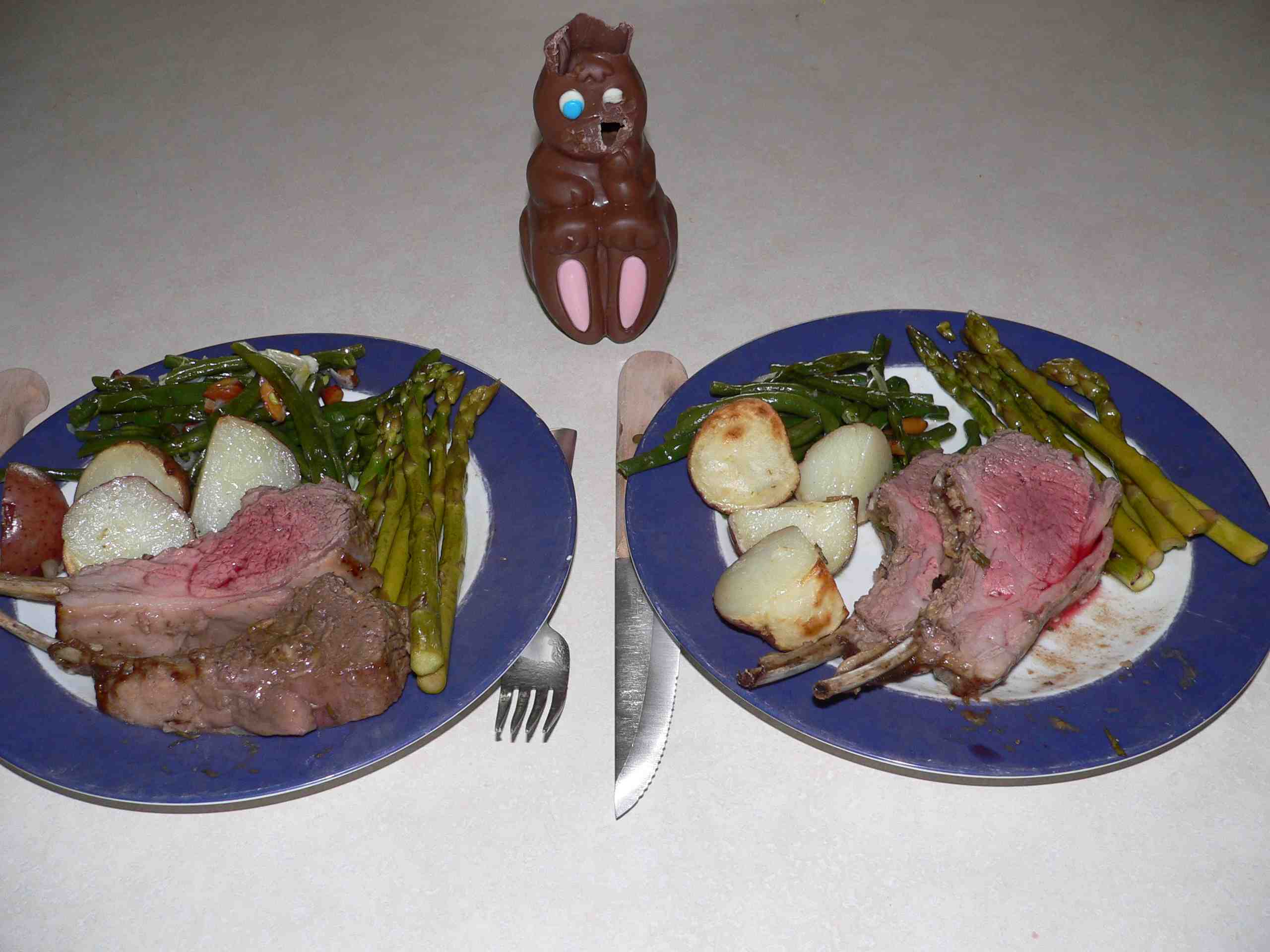
I don’t buy gifts for holidays but I will cook and, in the case of Easter, share in the emergence of Spring.
We did some late shopping at the bigger Dillions in Manhattan (Kansas) because they have a better lamb selection and they often discount it as the  holiday in question approaches.
holiday in question approaches.
Despite being told they only had lamb leg roasts, I was able to find a four rib rack of lamb, Frenched, the ideal amount of meat for the three of us.
I marinated the lamb in a mustard-rosemary-oil-garlic-lime sorta mixture for about an hour, and then roasted along with potatoes in a 450F oven. Once the internal temperature reached about 125F I removed the lamb and it rose to the preferred 140F after 10 minutes of resting.
Also on the menu was new asparagus from some southern state and green beans with scallions, garlic and almonds.
Dessert was an aged goat milk (pasteurized) cheese on slices of whole grain baguette.
Temperature is critical, not only for safety but as an objective measure of cooking. Take that digital, tip-sensitive thermometer, and stick it in.
Sorenne enjoys her lamb pops almost as much as the nose of the chocolate bunny.



(1).jpg)
(1).jpg) Overcooking: This should be a crime recognized by the federal government. For the popular medium-rare, grill the meat exactly three minutes on one side (keeping the grill lid closed) and two minutes on the other. If you’re going to add cheese, let it melt on top for another minute (and keep that cover closed!). We like our burgers medium rare, so much we’ve even sent them back at restaurants when they go beyond medium.
Overcooking: This should be a crime recognized by the federal government. For the popular medium-rare, grill the meat exactly three minutes on one side (keeping the grill lid closed) and two minutes on the other. If you’re going to add cheese, let it melt on top for another minute (and keep that cover closed!). We like our burgers medium rare, so much we’ve even sent them back at restaurants when they go beyond medium.
.jpg)


 [D]ry them THOROUGHLY. That is, if you wash them.
[D]ry them THOROUGHLY. That is, if you wash them.
.jpg) who studied
who studied  The cover article was by another ag engineer, Nathan Anderson, who works with the FDA’s
The cover article was by another ag engineer, Nathan Anderson, who works with the FDA’s 

 But rarely is a thermometer found in the top chef kitchens. Last night, someone’s lamb looked raw and someone’s scallops were swimming, but the judges said they were perfectly cooked. How would they know? Sure, it’s a lot more fun to guess – and the new judge uses more pop culture references than I do – but I’d rather stick it in. And the cross-contamination was rampant in the kitchens last night.
But rarely is a thermometer found in the top chef kitchens. Last night, someone’s lamb looked raw and someone’s scallops were swimming, but the judges said they were perfectly cooked. How would they know? Sure, it’s a lot more fun to guess – and the new judge uses more pop culture references than I do – but I’d rather stick it in. And the cross-contamination was rampant in the kitchens last night..jpg)
 Dave Grohl, right, said, “Did someone offend the smores guy cause I think he spit on mine.”
Dave Grohl, right, said, “Did someone offend the smores guy cause I think he spit on mine.”.jpg)
 After 12 hours of preparation and baking, the 134-pound burger emerged Saturday at Mallie’s Sports Bar and Grill.
After 12 hours of preparation and baking, the 134-pound burger emerged Saturday at Mallie’s Sports Bar and Grill..jpg)